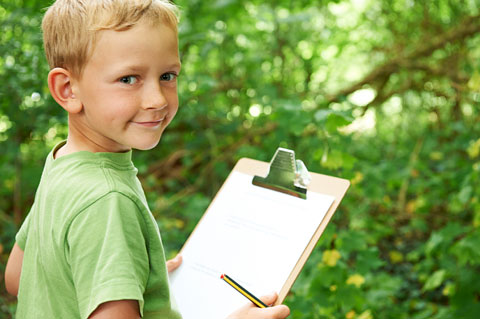Surveys are popular sources of information for adults. Young children can also use simple surveys. They can ask others for predictions related to a project or ask about others’ opinions, experiences, and work. When they do so, they can meet a number of Illinois Early Learning and Development Benchmarks, including 1.A.ECc, 1.B.ECb, 1.D.ECc, 5.A.ECb , 6.A.ECd, 6.D.ECa, 18.A.ECa, and 31.A.ECb.. Here are some teacher-tested suggestions for helping preschoolers conduct surveys.

Demonstrate ways to construct and take surveys.
- Let the children watch you making a survey form with a question that has two possible answers (“Yes/No”; “Agree/Disagree”). During a project on a dentist’s office, for example, you might pose the question, “Have you been to a dentist?” Attach your survey to a clipboard and go to the children one by one to ask the question. Show how to choose a column and make the check mark for a response.
- When you have surveyed all the children, report the findings to the class. Show them how to compare the two response columns. “You counted 8 checks in the ‘Yes’ column and 4 in the ‘No’ column. That means 8 people said they have been to a dentist and 4 said they have not.”
Help children to take their own surveys.
- Encourage them to work in pairs, or groups of 3 or 4.
- Talk with them about what they want to find out, and help them decide how to phrase the survey question. With experience, they may be able to create surveys with more than two possible responses.
- Help them decide whom to survey. Will the survey be for classmates, families, or someone else?
Let children take surveys during any phase of project work.
- In Phase 1, help children focus surveys on people’s opinions and experiences. Their questions might include, “Do you like to go to the dentist?” “Did you ever lose a tooth?”
- Encourage children to use surveys in Phase 2 to gather predictions related to the investigation, or to enhance fieldwork. They might ask questions such as, “Do you think we will see toothbrushes when we visit the dentist?” On the site visit, they might get permission to ask patients, “Are you scared of going to the dentist?”
- In Phase 3, let children survey classmates to choose ways the class might represent project findings. “Do you think we should make a model of the dentist’s chair or a mural of the office?” Phase 3 questions might also be reflective. “Do you think you might want to be a dentist someday?”
Make surveys a regular part of classroom life.
- Create survey templates to keep on hand, and have clipboards and pencils available. (Make inexpensive clipboards using stiff cardboard and paper clips.)
- Set aside time during class meetings for children to report on their surveys.


 Printer-friendly PDF
Printer-friendly PDF PDF para imprimir
PDF para imprimir